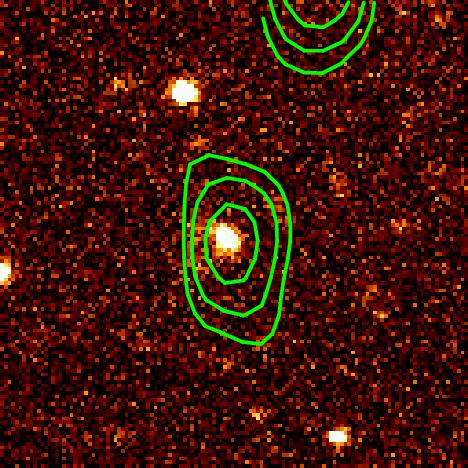|
Deep radio surveys reaching sub-mJy flux densities have revealed a new
population of apparently faint radio sources below the flux density of
1mJy. This new radio population has properties significantly
different form brighter radio sources (>10mJy) usually
identified with quasars (QSOs) and giant ellipticals harboring a
powerful Active Galactic Nucleus (AGN).
Indeed, photometric and spectroscopic studies of apparently faint
(sub-mJy and µJy) radio sources reveal that these objects are
usually identified with disc type galaxies at intermediate and high
redshifts. Their optical spectra exhibit narrow emission lines
indicative of star-formation activity, although a contribution
from an obscured AGN cannot be excluded and is under debate. The
similarity of these objects with the nearby population of starbursts
revealed by IRAS suggest that the sub-mJy faint radio population is
the more distant counterpart of these nearby galaxies.
The Phoenix Deep Survey is an ongoing project aiming to study
the nature and the evolution of the apparently faint radio
population. The observations comprise an ultra-deep and homogeneous
radio survey (1.4GHz) covering an area of 3 deg2 and
reaching µJy sensitivities. This is combined with
multiwavelength photometric data (UV, optical, near- and far-
infrared) and optical spectroscopy. Moreover, deep X-ray observations
(50ksec) using the XMM have recently
been obtained. This unique multiwavelength data-set is used to
address the following issues:
- elucidate the nature of the energising source (AGN or star-formation)
that dominates the observed activity of the apparently faint sub-mJy
radio sources.
- study the cosmological evolution of sub-mJy radio galaxies to
constrain galaxy formation and evolution models.
- investigate the evolution of the global star-formation rate. If
the sub-mJy faint radio population is indeed dominated by
starburst activity (as present studies indicate) then deep radio
surveys, like Phoenix, offer an efficient tool of identifying and
selecting the most active starburst galaxies out to z=1-2. Moreover,
the insensitivity of radio wavelengths to dust obscuration makes radio
surveys an unbiased census of the star-formation rate evolution unlike
UV/optical data.
- explore the significance of
interactions and mergers
in triggering the observed activity in sub-mJy radio
sources.
- explore the association of the sub-mJy radio population with
other classes of extra-galactic sources, also believed to be starburst
and/or AGNs at intermediate and high redshifts. These include the
X-ray detected Narrow Emission-Line Galaxies (NELGs), the Extremely Red Objects
(EROs) and the excess blue galaxies detected in deep
optical surveys. Such a study will provide direct links between
potentially similar objects selected at different wavelengths,
providing complementary information necessary to elucidate their
nature.
| 
